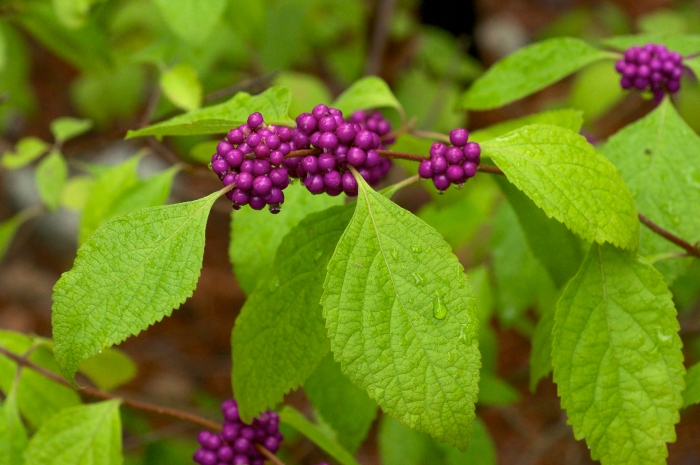American Beautyberry
(Callicarpa americana)
American Beautyberry (Callicarpa americana)
/
/

Eric Hunt
CC BY-SA 3.0

























Estimated Native Range
Summary
American Beautyberry is valued for its wildlife appeal and ornamental berries, which can also be used to make jellies and wine. It is commonly used in native plant gardens, as a specimen in landscape designs, and for naturalized areas. This shrub is adaptable to a range of soil types, prefers moist but well-drained soil, and thrives in full sun to part shade. It is relatively low maintenance but benefits from annual pruning to encourage denser foliage. Propagation is versatile, including cuttings, seed sowing, and natural seed dispersal by wildlife. While generally pest-free, it can occasionally suffer from leaf spot or powdery mildew.CC BY-SA 4.0
Plant Description
- Plant Type: Shrub
- Height: 3-5 feet
- Width: 3-6 feet
- Growth Rate: Moderate
- Flower Color: Pink, Purple
- Flowering Season: Summer
- Leaf Retention: Deciduous
Growth Requirements
- Sun: Full Sun, Part Shade
- Water: Medium, High
- Drainage: Medium
Common Uses
Bee Garden, Bird Garden, Border Plant, Butterfly Garden, Deer Resistant, Drought Tolerant, Edible*Disclaimer: Easyscape's listed plant edibility is for informational use. Always verify the safety and proper identification of any plant before consumption., Fragrant, Low Maintenance, Potted Plant, Salt Tolerant, Street Planting
Natural Habitat
Open woodlands, forest edges, and pine flatwoods
Other Names
Common Names: American Beauty-Berry, Beauty-Berry, French-Mulberry
Scientific Names: , Callicarpa americana, Callicarpa americana var. alba, Callicarpa americana var. lactea, Callicarpa americana f. lactea, Burchardia americana, Burchardia callicarpa, Callicarpa americana var. purpurea, Callicarpa serrata, Callicarpa viburnifolia
GBIF Accepted Name: Callicarpa americana L.